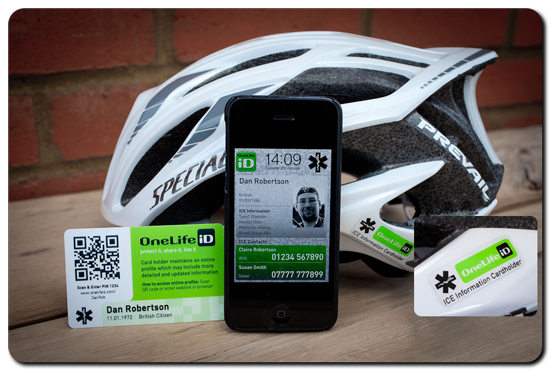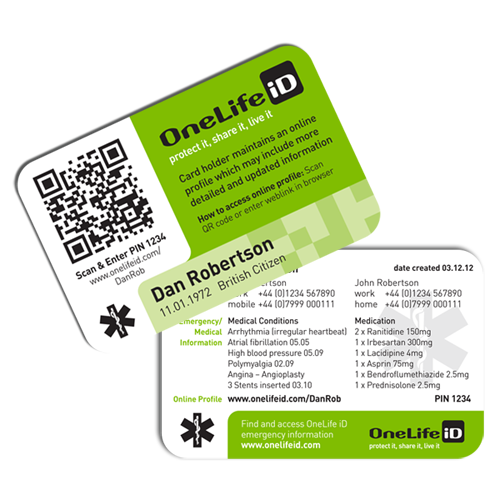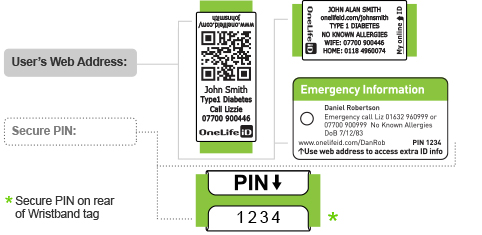OneLife iD survey on wearing in case of emergency (ICE) ID band

Cycling is booming in the UK, take to the road at weekends and it is clear that participation on two wheels is at an all time high.
With car speeds on UK’s local A roads faster than ever* cyclists are becoming increasingly aware about safety and the need to carry a useful form of personal ID with ICE (in case of emergency) medical and contact information.
Keen to find out more about cyclists’ views on carrying ICE information, new British Sports ID company OneLife iD conducted a recent survey**.
Cyclists and ID
The findings showed that 95% of respondents recognised the importance of carrying an ICE ID when cycling but over 60% admitted to not always using one.
While over 85% clearly recognised the benefits of using an ID nearly 35% of those surveyed had not really considered using one. The benefits were widely understood with quick next of kin contact identified as the main factor followed by communicating key personal information and a medical alert for medical conditions or allergies.
Of those surveyed 70% regarded the ICE ID wristband as most convenient to use followed by Stickers or labels (46%), mobile phone lock screen image (35%) and ID card (30%).
OneLife iD Ride Safe Campaign
In January 2013, OneLife iD launched their Ride Safe campaign with the objectives of:
- raising awareness of the benefits of wearing an ICE ID writband or product
- improving understanding of which ICE information is beneficial
- making carrying an ID easier and part of ‘ride routine’
The benefits of a personal ID seem reasonably well understood but an area of uncertainty was what headline information to print or engrave on the ID. There is no right and wrong but basic personal details and contacts plus photo and date of birth help with confirming identification. Additionally, the mnemonic ‘AMPLE’ is sometimes used by ‘first responders’ at the scene of an incident to prioritise their actions, and the first three letters ‘AMP’ (Allergies, Medication and Past medical history) can be provided on many ID products.

ID options for all
OneLife iD are now focusing on making ID part of a cyclist’s (or anyone else in fact) routine. Cyclists want to be able to select from variety of personal ID formats that suit their lifestyle, yet are simple and easy to use. In response, OneLife iD has continued to add several new products to their original iD band range including ID stickers, mobile phone ICE screens and a Card iD.
OneLife iD co-founder Craig Wilson said, “every cyclist or outdoor sportsman and woman has different personal ID needs. For some ID is just about providing their partner with some peace of mind, so they prefer a solution that integrates totally with their busy routine and this is where the mobile phone lock screen or helmet stickers come in – typically riders always wear a helmet or carry their mobile”. He went on to state, “there are other people, still leading active lifestyles despite quite complex past medical histories. In these situations, whether they are cycling, walking or on the golf course, they may need a combination of products with increasing levels of detail”. OneLife iD have found that in this scenario key details on the iD band grab attention, the Card ID provides additional printed information and the online profile can be accessed by typing the web link into a browser or scanning the QR code. The web based profile is where OneLife iD comes into its own, information can be updated, expanded and can hold more detailed, multi-page medical documentation or images.
Of course it is not all serious and part of the appeal is that it can be used as a social networking tool with links to social media or contact details. For example, the inclusion of the Strava button provides the opportunity for cyclists to exchange details and compare ride stats.
iD made easy
Carrying a personal ID helps enable effective and prompt emergency treatment, quick ICE contact and peace of mind. So whether it is cycle commuting, training or participating in events, personal IDs should offer users choice, ease of use and flexibility so that wearing or carrying an ID becomes second nature for all cyclists.
* DfT Transport Statistics Dec 2012 **OneLife iD Survey January 2013

